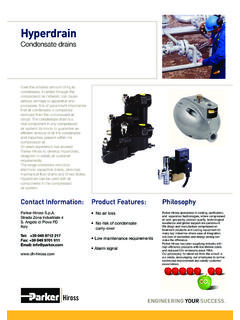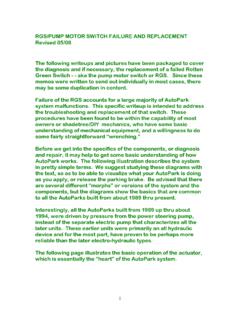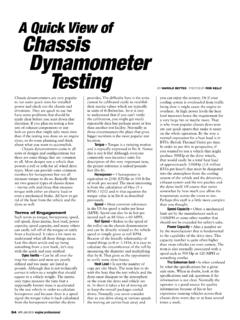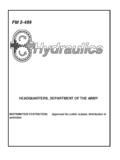Transcription of The Handbook of Hydraulic Filtration - esmagroup.com
1 The Handbook of Hydraulic Filtration The Handbook of Hydraulic Filtration is intended to familiarize the user with all aspects of Hydraulic and lubrication Filtration from the basics to advanced technology. It is dedicated as a reference source with the intent of clearly and completely presenting the subject matter to the user, regardless of the individual level of expertise. The selection and proper use of Filtration devices is an important tool in the battle to increase production while reducing manufacturing costs. This Handbook will help the user make informed decisions about Hydraulic Filtration . Table of Contents SECTION PAGE. Contamination basics 2.
2 Contamination Types and Sources 4. Fluid Cleanliness Standards 12. Filter Media Types and Ratings 16. Filter Media Selection 20. Filter Element Life 22. Filter Housing Selection 24. Types and Locations of Filters 28. Fluid Analysis 32. Appendix 34. 1. Contamination basics Filtration Fact Contamination Causes Most Hydraulic Failures If any one of these functions is impaired, the Hydraulic system will not perform as designed. The resulting Properly sized, installed, and The experience of designers and users downtime can easily cost a large manu- maintained Hydraulic of Hydraulic and lube oil systems has facturing plant thousands of dollars verified the following fact: over 75% of Filtration plays a key role per hour.
3 Hydraulic fluid maintenance all system failures are a direct result helps prevent or reduce unplanned in machine preventative of contamination! downtime. This is accomplished maintenance planning. through a continuous improvement The cost due to contamination is program that minimizes and removes staggering, resulting from: contaminants. Filtration Fact Loss of production (downtime). Component replacement costs Contaminant Damage The function of a Hydraulic Frequent fluid replacement Orifice blockage filter is to clean oil, but the Costly disposal Component wear ultimate purpose is to Increased overall maintenance costs Formation of rust or other oxidation reduce operating costs.
4 Increased scrap rate Chemical compound formation Depletion of additives Functions of Hydraulic Fluid Biological growth Filtration Fact Contamination interferes with the four functions of Hydraulic fluids: Hydraulic fluid is expected to create a The disposal cost of a lubricating film to keep precision parts 1. To act as an energy transmission drum of waste oil can be medium. separated. Ideally, the film is thick enough to completely fill the clearance 4X - 5X the cost of a 2. To lubricate internal moving parts of between moving parts. This condition drum of new oil. components. results in low wear rates. When the 3. To act as a heat transfer medium.
5 Wear rate is kept low enough, a compo- 4. To seal clearances between moving nent is likely to reach its intended life parts. expectancy, which may be millions of pressurization cycles. Actual photomicrograph of particulate contamination (Magnified 100x Scale: 1 division = 20 microns). 2. Contamination basics The actual thickness of a lubricating film depends on fluid viscosity, applied Typical Hydraulic load, and the relative speed of the two Component Clearances surfaces. In many components, mech- anical loads are to such an extreme Component Microns that they squeeze the lubricant into a Anti-friction bearings very thin film, less than 1 micrometer Vane pump (vane tip to outer ring) thick.
6 If loads become high enough, the Gear pump (gear to side plate) film will be punctured by the surface Servo valves (spool to sleeve) 1-4. roughness of the two moving parts. The result contributes to harmful Hydrostatic bearings 1-25. friction. Piston pump (piston to bore) 5-40. Servo valves flapper wall 18-63. Actuators 50-250. Servo valves orifice 130-450. Micrometer Scale Relative Sizes of Particles Particle sizes are generally measured on the micrometer scale. One microm- Substance Microns Inches eter (or micron ) is one-millionth of Grain of table salt 100 .0039 one meter, or 39 millionths of an inch. Human hair 70 .0027 The limit of human visibility is approx- Lower limit of visibility 40.
7 0016 imately 40 micrometers. Keep in mind Milled flour 25 .0010 that most damage-causing particles in Hydraulic or lubrication systems are Red blood cells 8 .0003. smaller than 40 micrometers. Bacteria 2 .0001 Therefore, they are microscopic and cannot be seen by the unaided eye. 3. Contamination Types and Sources Filtration Fact Types of Contamination New fluid is not necessarily 1. Particulate Silt (0-5um) Silt clean fluid. Typically, new Chips (5um+). fluid right out of the drum is Flow 2. Water not fit for use in Hydraulic or (Free & Dissolved). lubrication systems. Filtration Fact 3. Air Additives in Hydraulic fluid are generally well below 1 micron in size and are unaffected by standard Particulate Filtration methods.
8 Contamination Types Particulate contamination is generally classified as silt or chips. Silt can be defined as the accumulation of particles less than 5 m over time. This type of contamination also causes system component failure over time. Chips on the other hand, are particles 5 m+ and can cause immediate catastrophic failure. Both silt and chips can be further classified as: Hard Particles Soft Particles Silica Rubber Carbon Fibers Metal Micro organism 4. Contamination Types and Sources Damage A B If not properly flushed, contaminants A. Three-body from manufacturing and assembly will mechanical interactions can be left in the system. result in interference.
9 B. Two-body wear is These contaminants include dust, common in Hydraulic welding slag, rubber particles from components. hoses and seals, sand from castings, C D Stress raisers caused C. Hard particles can by particle collisions and metal debris from machined com- create three-body wear to generate ponents. Also, when fluid is initially more particles. added to the system, contamination is D. Particle effects can introduced. begin surface wear. During system operation, contamina- tion enters through breather caps, Sources worn seals, and other system openings. Built-in during manufacturing and Ingested from outside the system System operation also generates inter- assembly processes.
10 During operation. nal contamination. This occurs as component wear debris and chemical Added with new fluid. Internally generated during byproducts react with component sur- operation (see chart below). faces to generate more contamination. Generated Contamination Abrasive Wear Hard particles Erosive Wear Fine particles in bridging two moving surfaces, a high speed stream of fluid eat scraping one or both. away a metering edge or critical surface. Cavitation Wear Restricted inlet flow to pump causes fluid Adhesive Wear Loss of oil film voids that implode causing allows metal to metal contact shocks that break away critical between moving surfaces.











